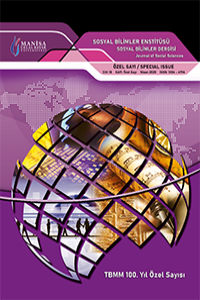Öz
The aim of this study is to shed light on the type of experience people use in choosing the source concepts of their metaphors. To this end, the following research question is posed: Are sensory or extra-sensory experiences more determinative in choosing the source concepts of metaphors? Participants of the study were asked to complete a number of metaphors with possible source concepts. Abstract source concepts predominated at all times the use of concrete ones by the participants. Results of this study indicate that what is more ‘experiential’ does not necessarily mean ‘what is attained through sense experiences’. Our experiential world is complex and incorporates many feelings, emotions, and ideas which can be closer to our cognition than sensory experiences in choosing the source concepts of metaphors.
Anahtar Kelimeler
Kaynakça
- Grady, J. E. (2007). Metaphor. In D. Geeraerts, & H. Cuyckens (Eds.). The Oxford handbook of cognitive linguistics (pp.188-213). New York: Oxford University Press.
- Katz, A. N. (1989). On choosing the vehicles of metaphors: Referential concreteness, semantic distances, and individual differences. Journal of Memory and Language, 28(4), pp.486-499.
- Kövecses, Z. (2017). The conceptual metaphor. In E. Semino & Z. Demjen (Eds.), The Routledge handbook of metaphor and language (pp.13-28). New York: Routledge.
- Lakoff, G., & Johnson, M. (1999). Philosophy in the flesh: The embodied mind and its challenge to Western thought. New York: Basic Books.
- Lakoff, G., & Johnson, M. (1980). Metaphors we live by. Chicago & London: The University of Chicago Press.
- Margolies, S. O. (2008). Event valence and spatial metaphors of time. Cognition & Emotion, 22 (7), pp. 1401-1414.
- Moore, K. E. (2006). Space-to-time mappings and temporal concepts. Cognitive Linguistics, 17(2), pp. 199-244.
- Ramscar, M., Boroditsky L., & and Matlock, T. (2010). Time, motion and meaning: The experiential basis of abstract thought. In K. S. Mix, L. B. Smith, and M. Gasser (Eds.), The spatial foundations of language and cognition (pp. 67-82). Oxford: OUP.
- Rapp, C. "Aristotle's Rhetoric", The Stanford Encyclopedia of Philosophy (Winter 2008 Edition), Edward N. Zalta (ed.), URL =<http://plato.stanford.edu/archives/win2008/entries/aristotle-rhetoric/>.
- Shen, Y. (1999). Principles of metaphor interpretation and the notion of ‘domain’: A proposal for a hybrid model. Journal of Pragmatics, 31(12), pp.1631-1653.
Duyumsal veya Duyumdışı Temeller? Metaforların Kaynak Kavramlarının Deneyimsel Özelliklerine İlişkin bir Çalışma
Öz
Bu çalışmanın amacı, metaforların kaynak kavramlarına karar verirken kişilerin ne tür deneyimlerden yararlandıklarına ışık tutmaktır. Bu bağlamda şu araştırma sonusuna yanıt aranmıştır: Kaynak kavramların belirlenmesinde duyumsal mı yoksa duyum-dışı deneyimler mi etkilidir? Katılımcılardan, bir dizi metaforu kendilerine uygun gelen kaynak kavramlarla tamamlamaları istenmiştir. Katılımcılar, soyut kaynak kavramlarını, her defasında somut kavramlara göre daha yoğun olarak tercih etmişlerdir. Çalışmanın sonuçları göstermektedir ki, ‘daha deneyimsel’ olan kavramlar mutlaka ‘duyularla algılanarak oluşturulan’ kavramlar demek değildir. Deneyimsel dünyamız karmaşıktır ve duygu, düşünce ve fikirleri gösteren pek çok soyut kavram bilişimize somut kavramlardan daha yakın olabilmektedir.
Anahtar Kelimeler
Kaynakça
- Grady, J. E. (2007). Metaphor. In D. Geeraerts, & H. Cuyckens (Eds.). The Oxford handbook of cognitive linguistics (pp.188-213). New York: Oxford University Press.
- Katz, A. N. (1989). On choosing the vehicles of metaphors: Referential concreteness, semantic distances, and individual differences. Journal of Memory and Language, 28(4), pp.486-499.
- Kövecses, Z. (2017). The conceptual metaphor. In E. Semino & Z. Demjen (Eds.), The Routledge handbook of metaphor and language (pp.13-28). New York: Routledge.
- Lakoff, G., & Johnson, M. (1999). Philosophy in the flesh: The embodied mind and its challenge to Western thought. New York: Basic Books.
- Lakoff, G., & Johnson, M. (1980). Metaphors we live by. Chicago & London: The University of Chicago Press.
- Margolies, S. O. (2008). Event valence and spatial metaphors of time. Cognition & Emotion, 22 (7), pp. 1401-1414.
- Moore, K. E. (2006). Space-to-time mappings and temporal concepts. Cognitive Linguistics, 17(2), pp. 199-244.
- Ramscar, M., Boroditsky L., & and Matlock, T. (2010). Time, motion and meaning: The experiential basis of abstract thought. In K. S. Mix, L. B. Smith, and M. Gasser (Eds.), The spatial foundations of language and cognition (pp. 67-82). Oxford: OUP.
- Rapp, C. "Aristotle's Rhetoric", The Stanford Encyclopedia of Philosophy (Winter 2008 Edition), Edward N. Zalta (ed.), URL =<http://plato.stanford.edu/archives/win2008/entries/aristotle-rhetoric/>.
- Shen, Y. (1999). Principles of metaphor interpretation and the notion of ‘domain’: A proposal for a hybrid model. Journal of Pragmatics, 31(12), pp.1631-1653.
Ayrıntılar
| Birincil Dil | İngilizce |
|---|---|
| Bölüm | Makaleler |
| Yazarlar | |
| Yayımlanma Tarihi | 28 Nisan 2020 |
| Yayımlandığı Sayı | Yıl 2020 TBMM 100. Yıl Özel Sayısı |


